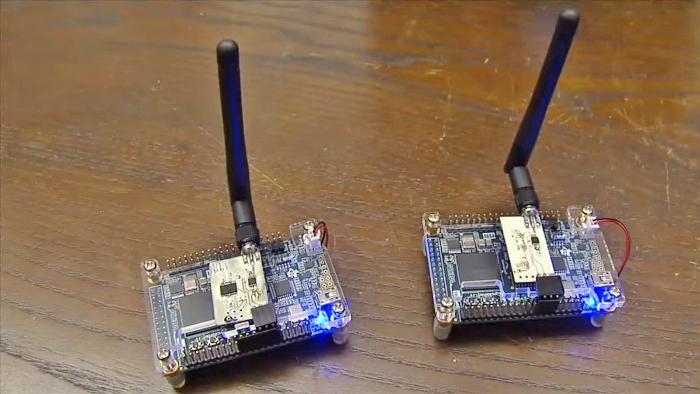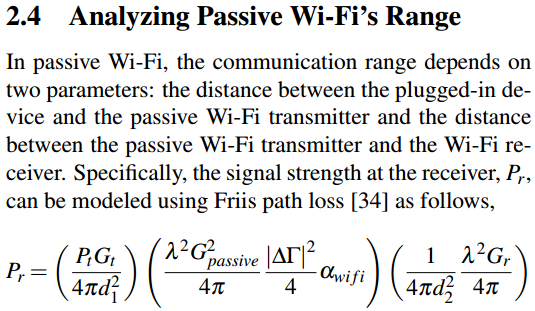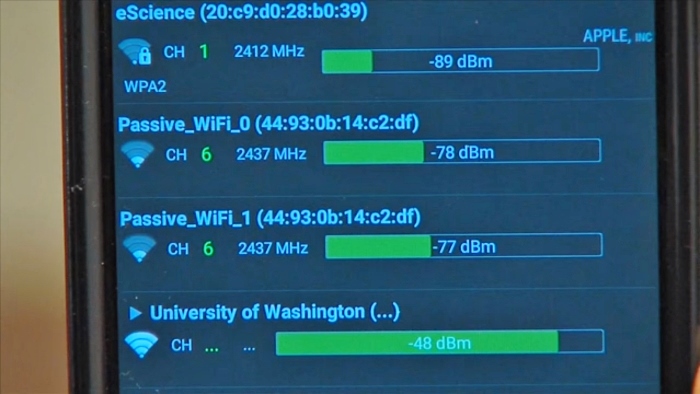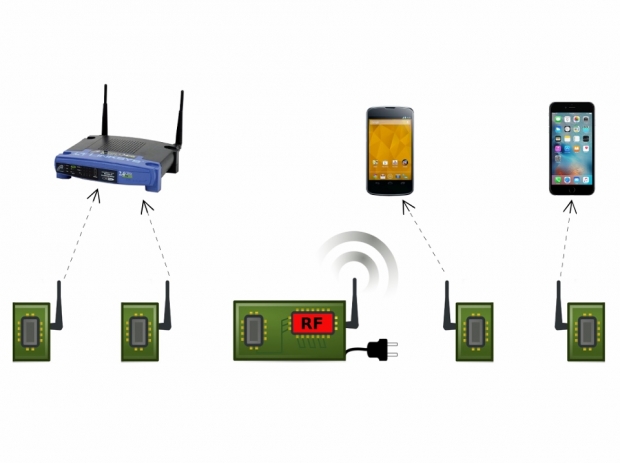
Source: University of Washington
Aimed primarily at the rapidly expanding Internet of Things (IoT) market, “Passive Wi-Fi” solves the problem of power consumption by operating on the scale of microwatts (uW) rather than milliwatts (mW), allowing for efficiency savings on the order of four orders of magnitude (1/10000th) the power of standard Wi-Fi devices, and three orders of magnitude (1/1000th) lower than ZigBee devices.
The paper is titled Passive Wi-Fi: Bringing Low Power to Wi-Fi Transmissions (March 2016) and proposes an active Wi-Fi transmitter sending a single frequency Wi-Fi “carrier wave” in all directions (omnidirectional), which is then absorbed by passive devices that reflect the signal and re-transmit it to IoT devices, smartphones, routers and other Wi-Fi devices.
“We wanted to see if we could achieve Wi-Fi transmissions using almost no power at all…That’s basically what Passive Wi-Fi delivers. We can get Wi-Fi for 10,000 times less power than the best thing that’s out there,” said co-author and assistant professor Shyam Gollakota in a press release.
The engineers tested their system under a variety of conditions, including line-of-sight and through walls, and were able to achieve successful communication at ranges of 30 to 100 feet (9 - 30 meters). Power consumption for passive devices varied with bit rate. At 11 Mbps, the devices used less than 60 uW (microwatts). The same devices drew a mere 15 uW when transmitting at 1 Mbps. This is a whopping four orders of magnitude (one ten-thousandth) of the power that normal WiFi uses, and three orders of magnitude (one one-thousandth) lower than ZigBee.
Source: University of Washington
The University of Washington engineers ran the experiment on the campus Computer Science and Engineering atrium, where the passive Wi-Fi device and Wi-Fi receiver (an HTC One M7 smartphone in this case) were separated by 100 feet. The experiment was conducted over the 802.11b protocol at 1Mbps with 68-byte packets transmitted every 15 milliseconds. A second experiment was conducted with an Intel 5350 was the Passive Wi-Fi receiver, which was able to receive 802.11b bit rates of 1, 2, 5.5 and 11Mbps. The experiments showed that Passive Wi-Fi only adds a small fixed 100-microsecond overhead to the signal. However, the researchers claim this small overhead is “overshadowed by transient changes in network conditions.”
Source: University of Washington
The team concluded that such low bit-rate Passive Wi-Fi power intensities can be useful for three applications, among others – low power microphones, low power cameras, and duty cycled sensors such as iBeacon and home proximity sensors using Bluetooth LE (Low Energy) and ZigBee protocols.
In the low-power camera example, the researchers conclude that “using an IoT WiFi chipset from Gainspan or TI brings the total power consumption of the system to 680 mW. If we substitute an active Wi-Fi chipset which consumes 670 mW of power with 11 Mbps passive Wi-Fi [which uses only 65 µW], we can improve the battery life of Wi-Fi video camera by at least 50x.”
In the duty cycled sensor example, the researchers note that Bluetooth LE and ZigBee transmitters typically consume 35 mW and send data at a rate of 100ms to 900ms between 3 months to 3 years by operating on a coin cell battery. By replacing the Bluetooth LE / ZigBee transmitter with Passive Wi-Fi consuming only 15 µW, “the battery life can be extended well beyond 10 years.”
Source: University of Washington (YouTube)
“Our sensors can talk to any router, smartphone, tablet or other electronic device with a Wi-Fi chipset,” said co-author and electrical engineering doctoral student Bryce Kellogg. “The cool thing is that all these devices can decode the Wi-Fi packets we created using reflections so you don’t need specialized equipment.”
Already, one company called Jeeva Wireless is allowing battery-free devices to connect with smartphones, tablets, laptops and other standard Wi-Fi devices by “backscattering” Wi-Fi signals to make them passive. Achieving this requires altering the software of a Wi-Fi access point to generate an extra signal for Passive Wi-Fi devices. This process slightly raises total system power consumption, but it is very negligible on the scale of microwatts.
The technology has already been named one of the “10 breakthrough technologies of 2016” by MIT Technology Review. A paper describing the results of the Washington University Wireless Lab will be presented later this month at the 13th annual USENIX Symposium on Networked Systems Design and Implementation in Santa Clara, California. The technology is expected to become readily available in 2 to 3 years.
YouTube - Passive Wi-Fi (February 2016)




